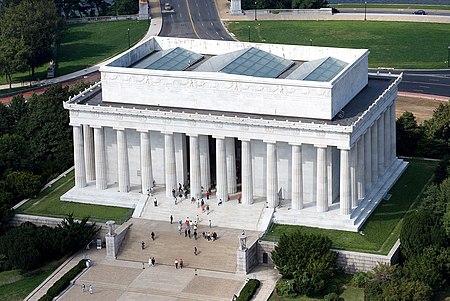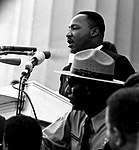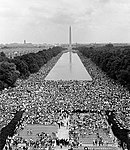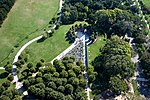Lincoln Memorial

The Lincoln Memorial is a US national memorial built to honor the 16th president of the United States, Abraham Lincoln. It is on the western end of the National Mall in Washington, D.C., across from the Washington Monument, and is in the form of a neoclassical temple. The memorial's architect was Henry Bacon. The designer of the memorial interior's large central statue, Abraham Lincoln (1920), was Daniel Chester French; the Lincoln statue was carved by the Piccirilli brothers. The painter of the interior murals was Jules Guerin, and the epitaph above the statue was written by Royal Cortissoz. Dedicated in May 1922, it is one of several memorials built to honor an American president. It has always been a major tourist attraction and since the 1930s has sometimes been a symbolic center focused on race relations. The building is in the form of a Greek Doric temple and contains a large seated sculpture of Abraham Lincoln and inscriptions of two well-known speeches by Lincoln, the Gettysburg Address and his second inaugural address. The memorial has been the site of many famous speeches, including Martin Luther King Jr.'s "I Have a Dream" speech delivered on August 28, 1963, during the rally at the end of the March on Washington for Jobs and Freedom. Like other monuments on the National Mall – including the nearby Vietnam Veterans Memorial, Korean War Veterans Memorial, and World War II Memorial – the national memorial is administered by the National Park Service under its National Mall and Memorial Parks group. It has been listed on the National Register of Historic Places since October 15, 1966, and was ranked seventh on the American Institute of Architects' 2007 list of America's Favorite Architecture. The memorial is open to the public 24 hours a day, and more than 7 million people visit it annually.
Excerpt from the Wikipedia article Lincoln Memorial (License: CC BY-SA 3.0, Authors, Images).Lincoln Memorial
Lincoln Steps, Washington
Geographical coordinates (GPS) Address Website External links Nearby Places Show on map
Geographical coordinates (GPS)
| Latitude | Longitude |
|---|---|
| N 38.889277777778 ° | E -77.050138888889 ° |
Address
Lincoln Memorial
Lincoln Steps
20418 Washington
District of Columbia, United States
Open on Google Maps









